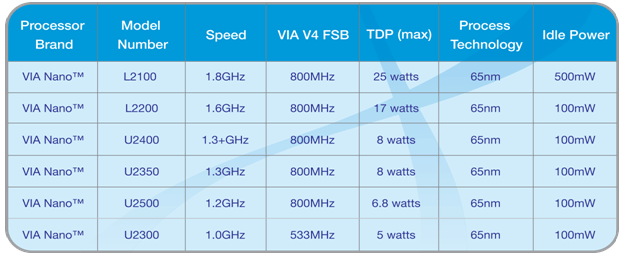
VIA has launched a new Nano processor as part of the new EPIA-SN mini-itx platform and promises a revolutionary jump in performance compared to previous VIA CPUs.
The Nano, formerly codenamed Isaiah, features a x86-64-bit superscalar design and is built on a 65nm process technology between TSMC and Fujitsu. This technology is further complemented by the fact the entire design is completely lead and halogen-free and is fully compliant with RoHS and WEEE regulations.
The NanoBGA2 package is just 63.3mm square and is pin-compatible with previous C7 CPUs, so mini-ITX EPIA boards can be easily interchanged at the manufacturing level, in addition to a simple BIOS update. Unfortunately, these are still hard-soldered to the board so there's no at-home upgrading still, sorry.
Other features include an 800MHz V4 FSB, the SSE instruction set, 64k L1 data and instruction cache and 1MB of 16-way associative L2 cache in its single core design. However the biggest performance increase is in the fact this is VIA's first processor with out of order issue and execution - something Intel has touted since the Pentium Pro, yet has removed for its Atom.
VIA has also introduced a new "C6" low power state (higher "C" numbers mean lower sleep states) cunningly branded Adaptive PowerSaver Technology. Finally VIA PadLock Security Engine is an on-die hardware cryptographic acceleration feature including dual quantum random number generators, AES encryption engine, SHA-1 and SHA-256 hashing and the standard NX-bit. We were told by VIA that this feature is apparently very popular in industry.

It's worth remembering that the Atom isn't directly comparable to the Nano L2100 - at 25W is Nano dwarfs the Atom's power use of 8W - you'd need to drop down to a 1.3GHz U2350 to match it here. In addition - the new VIA CN896 single chipset supports PCI-Express and four SATA , whereas the Atom platform is completely locked down to use Intel 945G northbridge and ICH7 southbridge which only features a pair of SATA and no PCI-Express.
However the platform costs are just as epically different - you can currently pick up an old C7 based VIA EPIA-SN for a wallet busting £160, whereas an Atom mini-ITX board can be found for the price of two pints of lager and a chicken curry.
Well be testing them both in addition to AMD's lowest power offering - all on mini-ITX - to understand what they are designed for and where their performance stops and where they overlap.
Are you still all wrapped up in Atomic love or have you just ignited a new flame for Nano's too? Let us know your thoughts, in the forums.
The Nano, formerly codenamed Isaiah, features a x86-64-bit superscalar design and is built on a 65nm process technology between TSMC and Fujitsu. This technology is further complemented by the fact the entire design is completely lead and halogen-free and is fully compliant with RoHS and WEEE regulations.
The NanoBGA2 package is just 63.3mm square and is pin-compatible with previous C7 CPUs, so mini-ITX EPIA boards can be easily interchanged at the manufacturing level, in addition to a simple BIOS update. Unfortunately, these are still hard-soldered to the board so there's no at-home upgrading still, sorry.
Other features include an 800MHz V4 FSB, the SSE instruction set, 64k L1 data and instruction cache and 1MB of 16-way associative L2 cache in its single core design. However the biggest performance increase is in the fact this is VIA's first processor with out of order issue and execution - something Intel has touted since the Pentium Pro, yet has removed for its Atom.
VIA has also introduced a new "C6" low power state (higher "C" numbers mean lower sleep states) cunningly branded Adaptive PowerSaver Technology. Finally VIA PadLock Security Engine is an on-die hardware cryptographic acceleration feature including dual quantum random number generators, AES encryption engine, SHA-1 and SHA-256 hashing and the standard NX-bit. We were told by VIA that this feature is apparently very popular in industry.

It's worth remembering that the Atom isn't directly comparable to the Nano L2100 - at 25W is Nano dwarfs the Atom's power use of 8W - you'd need to drop down to a 1.3GHz U2350 to match it here. In addition - the new VIA CN896 single chipset supports PCI-Express and four SATA , whereas the Atom platform is completely locked down to use Intel 945G northbridge and ICH7 southbridge which only features a pair of SATA and no PCI-Express.
However the platform costs are just as epically different - you can currently pick up an old C7 based VIA EPIA-SN for a wallet busting £160, whereas an Atom mini-ITX board can be found for the price of two pints of lager and a chicken curry.
Well be testing them both in addition to AMD's lowest power offering - all on mini-ITX - to understand what they are designed for and where their performance stops and where they overlap.
Are you still all wrapped up in Atomic love or have you just ignited a new flame for Nano's too? Let us know your thoughts, in the forums.

MSI MPG Velox 100R Chassis Review
October 14 2021 | 15:04








Want to comment? Please log in.